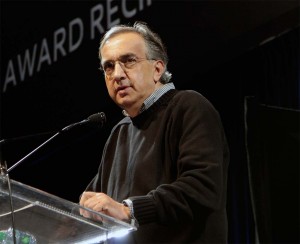
Marchionne currently spends much of his time shuttling between Fiat and Chrysler headquarters on both sides of the Atlantic.
Fiat SpA shares soared to nearly their highest level in a year on news that the Italian maker will soon complete its “defining” acquisition of U.S. alliance partner Chrysler for about $4.3 billion.
At the same time, Fiat’s top two executives urged workers on both sides of the Atlantic to “remain united” as the deal, nearly five years in the making, comes to a successful conclusion. But at least some union members in Italy were raising concerns about what the merger will mean, especially as Fiat-Chrysler CEO Sergio Marchionne continues pressing for further concessions while warning future production plans could shift away from Italy.
Indeed, one of the big questions is whether the newly merged company will be based in Italy, the U.S., or continue to operate with dual headquarters on either side of the Atlantic.
Fiat shares carried in the U.S. were up more than 11% in mid-morning during the first day of trading after the New Year’s break, running above $9.27. The shares were buoyed by the January 1st announcement that the maker had settled a long-standing dispute with a retiree health care fund, or VEBA, operated by the United Auto Workers Union.
Fiat has been holding a 58% stake in Chrysler, steadily building up its stake since the American automaker emerged from bankruptcy in 2009. But it had been rebuffed in efforts to acquire the nearly 42% remaining in the union’s account due to a disagreement over the stock’s value. They finally agreed to a purchase valued at roughly $4.3 billion.
(For more on the New Year’s Day deal, Click Here.)
The deal is expected to close by January 20th and head off a planned IPO of Chrysler stock that Marchionne had warned could derail the trans-Atlantic alliance.
Expressing strong “emotion” at seeing the prospects of a full merger finally within reach, Marchionne and Fiat Chairman John Elkan emailed employees of the two companies asking them to “remain united” to make Fiat-Chrysler “a model of speed and efficiency.”
“In reality, this extraordinary union already existed,” the two executives wrote. “Over the past few years, the two groups have learned to understand and trust each other. They have made each other stronger through the sharing of know-how and experience. They have committed to a common future.”
(Click Here to find out how Chrysler has been getting creative to bolster its bottom line.)
Analysts suggest that the deal will prove critical to the transformation of the smallest of the Detroit makers and a struggling European company into a true global powerhouse. But its success is far from certain, cautioned analyst Stephanie Brinley, of IHS Automotive. “That’s the next issue,” she said, “how do you take two weak players and create one strong player?”
The two makers have already merged a number of key operations such as product development. Rebadged Chrysler products have fleshed out the European Lancia line, for example, and platforms based on Fiat products are allowing the U.S. maker to expand its offerings. One of those, the new Jeep Cherokee sport-utility vehicle, is a finalist for North American Truck of the Year, a victory that could lend credence to Marchionne’s grand vision for the two makers.
One of the big questions, going forward, is where Fiat and Chrysler products will be built. As part of the bankruptcy process, a number of the U.S. maker’s facilities were closed. But since then, it has been struggling to meet booming demand that has seen Chrysler boost sales every month for the last three years. It cancelled plans to close an assembly plant in the Detroit suburb of Sterling Heights and a low-volume specialty plant was reopened in Detroit to produce the SRT Viper sports car.
On the other hand, Fiat has been trimming production in Europe, closing a Sicilian plant and threatening to stop investing in other Italian factories if it doesn’t get concessions from unions there. Of the maker’s 215,000 workers, 75,000 are based in Italy,
“It is indispensable that Fiat say what it intends to do in our country,” Susanna Camusso, leader of the nationwide, left-leaning CGIL labor confederation, said in a statement.
(Click Here to see how Chrysler and its Detroit rivals are pushing to rebuild their presence in import-friendly California.)
Cuts in capacity aren’t the only concerns. Marchionne has suggested he’d like to see Fiat’s stock, in the future, listed on the New York Stock Exchange. And even the question of where the headquarters of the combined company will be located. Up to now, the partners have been bifurcated, Marchionne himself dividing his time between the Chrysler tower and engineering complex in Auburn Hills, Michigan, and Fiat’s birthplace of Turin.
But even as some union members were worrying about Fiat’s long-term commitment to its home country, others took a more positive approach. “It is good news for Fiat workers, for the auto industry and for our country,” Giusppe Farina, leader of the FIM-CISL union, told the Associated Press.
Longer-term, the general sense seems to be that Fiat could not continue to compete with the big players in Europe, North America or Asia without completing the alliance with Chrysler that has been steadily falling into place over the last few years.

Any thoughts on what they’ll call this new company? Could they go with a corporate name that doesn’t include Fiat or Chrysler while using the brand names for the vehicles, sort of like General Motors?
My sense, Bryan, is that they will retain the Fiat-Chrysler name, though I have not heard anything official. There’d really be no reason to give up those brand identitites.
Paul E.
FCX? guess not, since Honda’s using it for their fuel cell vehicle